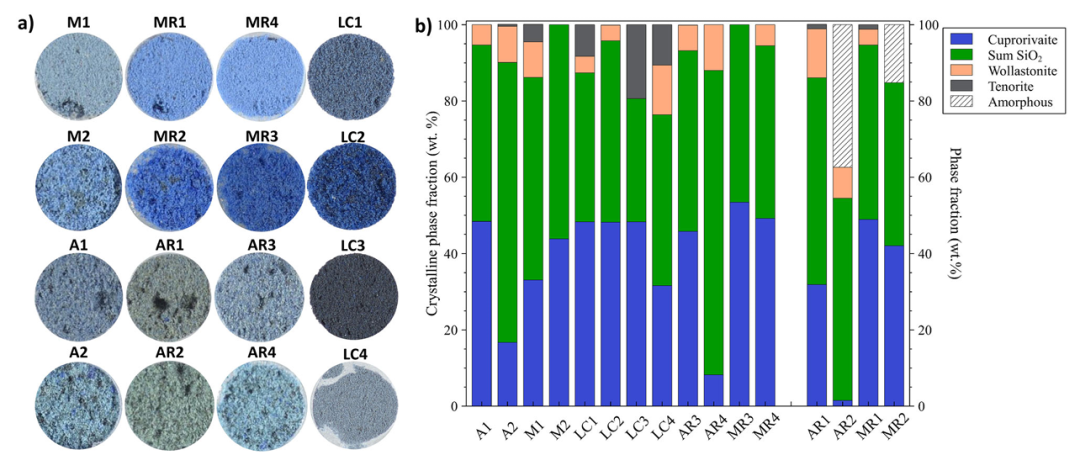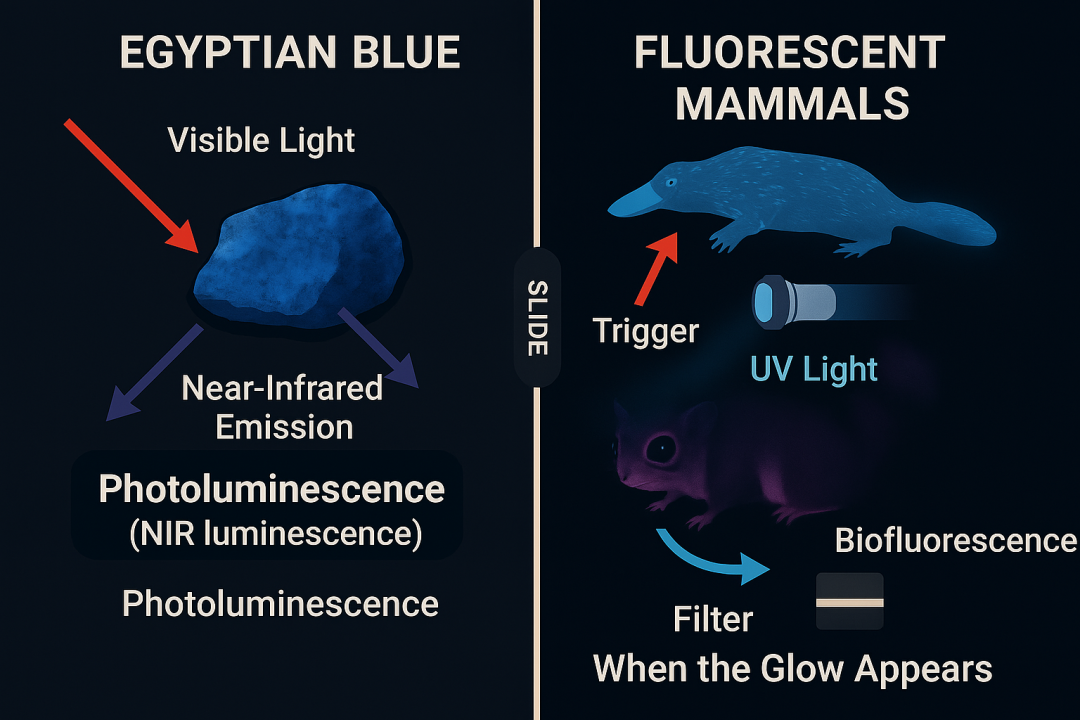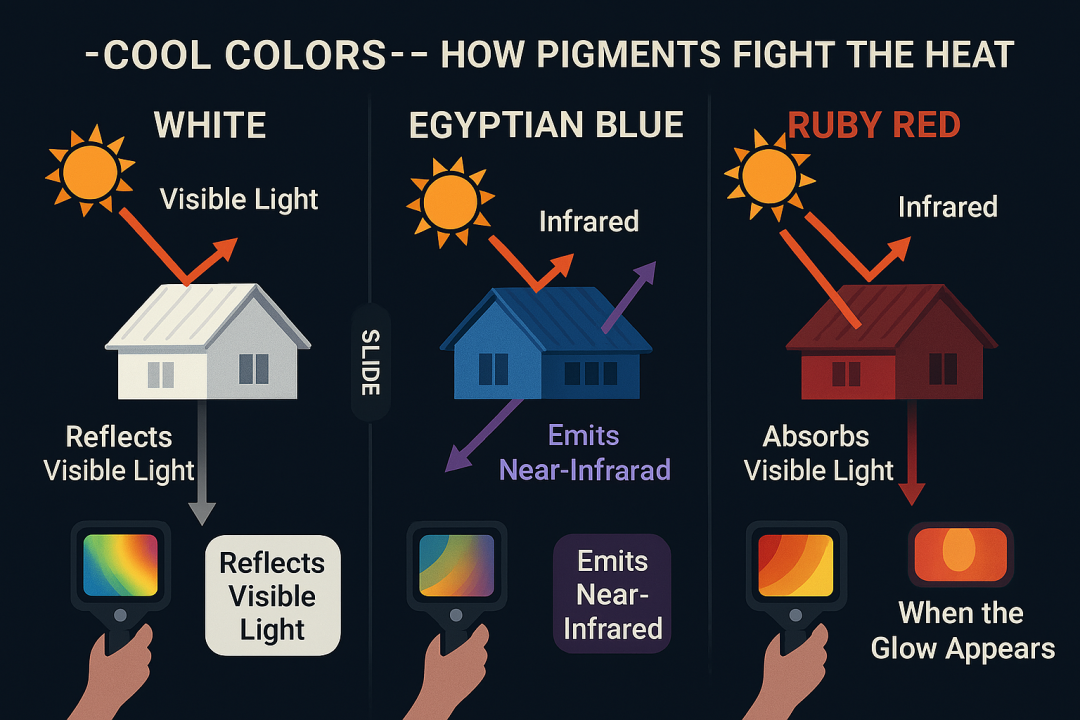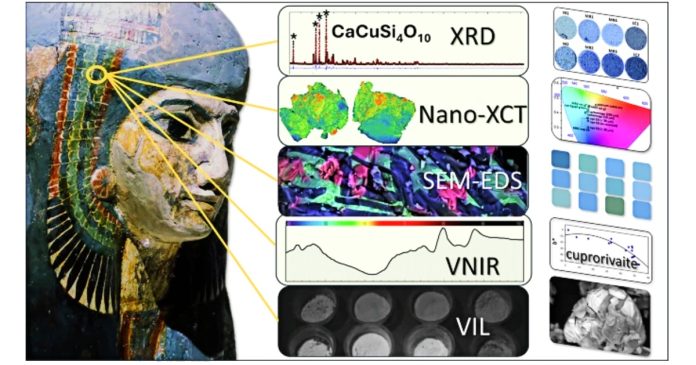Egyptian blue, the world’s first synthetic pigment, crafted over 5,000 years ago in ancient Egypt, blends vibrant color with surprising scientific powers. This striking blue, born from mineral mixtures and ancient ingenuity, glows under specialized light and keeps surfaces cool under intense sunlight. A 2025 study in npj Heritage Science explores how raw materials, crafting techniques, and internal structure shape Egyptian blue’s properties, revealing its potential for modern applications like artifact preservation, medical imaging, and eco-friendly architecture. This pigment bridges ancient technology with cutting-edge innovation.
Re-Creating Egyptian Blue: Secrets of the Ancients
Mixing Minerals for Brilliance

Researchers recreated Egyptian blue by making 12 batches, each with different ingredients and methods. They used copper sources like copper oxide, azurite (a blue mineral), and malachite (a green mineral), sometimes adding soda flux to alter the outcome. These mixtures were fired at 1,000°C for varying durations, replicating ancient kiln conditions. The process showed how Egyptians controlled color through careful choices.
Egyptian blue is a complex blend, not a single substance. Its vivid hue comes from a blue mineral, joined by silica (like quartz), wollastonite (a white mineral), and a glassy phase when soda flux is added. Remarkably, even when the blue mineral is only half the mix, the pigment retains its intense color. Soda flux creates a greenish tint by forming glass, while slower cooling boosts the blue mineral’s presence, deepening the hue. Larger particles produce richer blues, while smaller ones appear less vibrant, revealing the artistry behind ancient recipes.
Using High-Tech Tools Uncover the Past
The study employed advanced instruments to analyze Egyptian blue’s composition and structure:
- X-ray Diffraction (XRD): Pinpointed crystalline components like the blue mineral, silica, and wollastonite, showing their proportions.
- Raman Spectroscopy: Identified molecular fingerprints, confirming the glowing properties of the blue mineral.
- Scanning Electron Microscopy with Energy-Dispersive Spectroscopy (SEM-EDS): Mapped chemical elements and particle shapes, revealing impurities like potassium or aluminum.
- Nano-Computed Tomography (Nano-CT): Created 3D images of the pigment’s internal structure, showing how particles interlock.
- Visible-to-Near-Infrared Spectrometry (VNIR): Measured color by capturing reflected light, translated into CIE Lab* values for precise color mapping.
These tools painted a detailed picture of how ancient techniques and modern science align, showing Egyptian blue’s complexity and versatility.
A Glow That Hides in Plain Sight
Shining in Near-Infrared Light
Egyptian blue has a hidden talent: it absorbs visible light, especially red wavelengths (630–700 nm), and emits nearly twice as much energy in the near-infrared range (910–930 nm). This glow, called photoluminescence, comes from copper ions in the blue mineral’s crystal structure. To see it, scientists use red light to excite the pigment and a near-infrared camera with a long-pass filter to block visible light. The result is a radiant glow, invisible to the naked eye but vivid under the right conditions.
This property is a game-changer for archaeologists. Faded Egyptian blue on ancient artifacts, like pottery or wall paintings, can be detected non-invasively with near-infrared imaging, preserving delicate surfaces. Beyond heritage science, the pigment’s stable, non-toxic glow suits modern uses. In medical imaging, near-infrared light penetrates tissue better than visible light, making Egyptian blue ideal for scanning. It also works in security inks, glowing under specific light to verify documents or currency.
Nature’s Glow: A Comparison
Egyptian blue’s glow shares similarities with fluorescent mammals like platypuses and flying squirrels, which shine under ultraviolet (UV) light (300–400 nm). These animals emit visible colors [blue-green for platypuses, pink for flying squirrels] when viewed through a long-pass filter (450+ nm), thanks to organic compounds in their fur. Egyptian blue, by contrast, emits near-infrared light under red light, driven by its mineral structure. Unlike bioluminescent creatures like fireflies, which produce light through chemical reactions without external triggers, both Egyptian blue and fluorescent mammals need light to shine. This parallel highlights a shared principle: absorbing one type of light and re-emitting another, though Egyptian blue’s near-infrared output sets it apart for high-tech applications.
Here’s how they compare:

- Platypus: Glows blue-green under UV light, visible with a 450+ nm filter.
- Flying Squirrel: Shines bright pink under UV, detected with a long-pass filter.
- Egyptian Blue: Emits near-infrared under red light, visible only with near-infrared sensors.
This distinction makes Egyptian blue uniquely suited for invisible, durable glows in specialized settings.
Cooling the Planet with Ancient Color
A Pigment That Fights Heat
Egyptian blue has another scientific application; it cools. When sunlight hits it, the pigment absorbs visible light and radiates much of that energy as near-infrared light, preventing surfaces from heating up. A Berkeley Lab study found that Egyptian blue coated surfaces stay nearly as cool as those painted with white titanium dioxide, the standard for cool roofs. With up to 70% efficiency in emitting near-infrared light, it outperforms pigments like ruby red, which trap heat and warm surfaces.
This cooling power has practical uses. In hot climates, Egyptian blue could coat buildings to reduce air conditioning needs, saving energy. It might also power solar windows, where near-infrared emissions are captured by photovoltaic cells to generate electricity. In cities struggling with urban heat islands, this pigment offers a colorful way to keep temperatures down, combining aesthetics with sustainability.
How It Compares to Other Pigments
Egyptian blue stands out among cooling materials:

- Titanium Dioxide (White): Reflects most visible light, stays very cool, but lacks strong near-infrared emission.
- Egyptian Blue: Reflects some visible light, emits high near-infrared, stays cool despite its bold color.
- Ruby Red: Absorbs both visible and infrared light, heating up quickly.
This balance of vibrant blue and heat dissipation makes Egyptian blue a top choice for eco-friendly architecture.
A Legacy Through the Ages
The study analyzed artifacts like cartouches from Amarna (ca. 1340–1336 BCE) and Thebes (ca. 135–130 BCE), showing how Egyptian blue’s color varied with grain size, substrate, and ingredient tweaks. Ancient texts by Theophrastus and Pliny mention multiple shades, suggesting artisans deliberately adjusted recipes for effect. This sophistication, like crafting colored glass, fueled trade across Egypt and Rome, marking Egyptian blue as a prized commodity.
Today, its legacy lives on. Its near-infrared glow aids archaeologists in spotting faded pigment, while its cooling properties inspire sustainable designs, from energy-efficient buildings to solar-powered windows. Egyptian blue, born in the Nile Valley, proves that ancient ingenuity can light the way for modern innovation, glowing and cooling across millennia.

